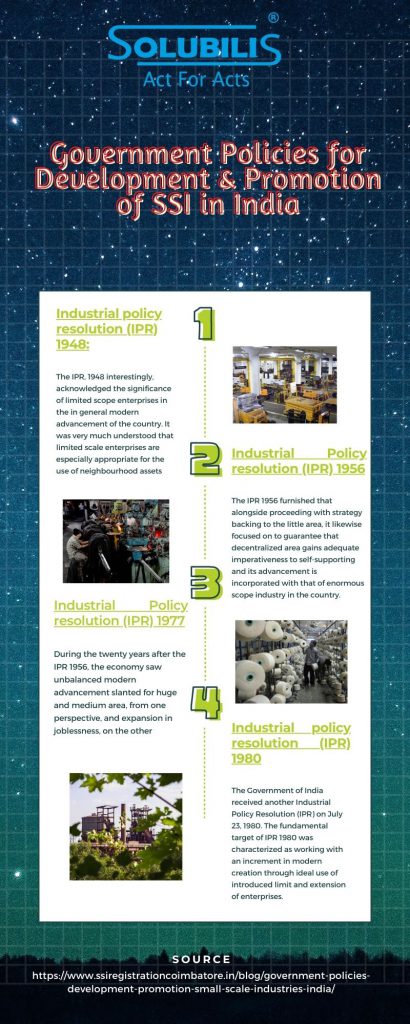Since Independence, India has a few Industrial Policies to her credit. To such an extent that Lawrence A. Veit enticed to say that “if India has as much industry as it has modern strategy, it would be a far wealthy country.” With this foundation in see, in what follows is a survey of India’s Industrial Policies for the turn of events and advancement of limited scope undertakings in the country. It has carried out to benefit SSI.
A portion of the Government Policies for advancement and advancement of Small-Scale Industries in India are: 1. The Industrial Policy Resolution (IPR) 1948, 2. Also Industrial Policy Resolution (IPR) 1956, 3. Another Industrial Policy Resolution (IPR) 1977, 4. Industrial Policy Resolution (IPR) 1980 and 5. And Industrial Policy Resolution (IPR) 1990.
Industrial Policy resolution (IPR) 1948:
The IPR, 1948 interestingly, acknowledged the significance of small scale industries in the in general modern advancement of the country. It was very much understood that limited scale enterprises are especially appropriate for the use of neighborhood assets; and for making of work openings.
Industrial Policy resolution (IPR) 1956
The primary commitment of the IPR 1948 was that it set in the nature and example of modern improvement . The post-IPR 1948 period had set apart by huge improvements occurred in the country. For instance, arranging has continued on a coordinated way and the First Five Year Plan 1951-56 had been finished. Ventures (Development and Regulation) Act, 1951 had likewise acquainted with direct and control enterprises in the country.
The IPR 1956 furnished that alongside proceeding with strategy backing to the little area, it likewise focused on to guarantee that decentralized area gains adequate imperativeness. It happens to self-supporting and its advancement has incorporation with that of enormous scope industry in the country. To make reference to, exactly 128 things had held for selective creation in the limited scale area. Besides, the Small-Scale Industries Board (SSIB) comprised a functioning gathering in 1959 to look at and detail an improvement plan for limited scope businesses during; Third Five Year Plan, 1961-66.

Industrial Policy resolution (IPR) 1977
During the twenty years after the IPR 1956, the economy saw unbalanced modern advancement slanted for huge and medium area. It happens from one perspective, and expansion in joblessness, on the other. The present circumstance prompted a restored accentuation on modern approach. This offered development to IPR 1977.
The IPR 1977 likewise ordered little area into three general classes:
1. Cottage and Household Industries which give self-employment for a huge scope.
2. Tiny sector incorporating investment in industrial units in plant and hardware up to Rs. 1 lakh and arranged in towns with a populace of under 50,000 as per 1971 Census.
3. Small Scale industries involving modern units with a venture of upto Rs. 10 lakhs and if there should arise an occurrence of auxiliary units with a speculation up to Rs. 15 lakhs.
The actions recommended for the advancement of small scale industries and the cottage industries included:
(I) Reservation of 504 things for select creation in small scale sector.
(ii) Proposal to set up in each locale an office called ‘District Industry Center’ (DIC) to fill in as a point of convergence of advancement for limited scope and cabin enterprises. The plan of DIC had presented in May 1978. The primary target of setting up DICs was to advance under a solitary rooftop every one of the administrations; and backing needed by little and town business people.
What follows from above is that to the previous push of insurance (IPR 1948) and improvement (IPR 1956). And the IPR 1977 added ‘advancement’. According to this goal, the little area was, hence, to have ‘ensured, created, and advanced.’
Industrial policy resolution (IPR) 1980
The Government of India received another Industrial Policy Resolution (IPR) on July 23, 1980. The fundamental target of IPR 1980 had characterized as working with an increment in modern creation. It is done through ideal use of introduced limit and extension of enterprises.

Industrial Policy resolution (IPR) 1990
The IPR 1990 had reported during June 1990. Concerning the limited scale area, the goal kept on giving expanding significance to limited scope ventures. Also to serve the goal of work age.
The important element in development of small-scale sector are:
(I) The investment ceiling in plant and apparatus for small scale industries (fixed in 1985) had raised from Rs. 35 lakhs to Rs. 60 lakhs and correspondingly, for subordinate units from Rs. 45 lakhs to Rs. 75 lakhs.
(ii) Investment ceiling for very small scale units had expanded from Rs. 2 lakhs to Rs. 5 lakhs gave the unit has situated in a space having a populace of 50,000 according to 1981 Census.
New plans,
(iii) As numerous as 836 things had held for select assembling in limited scope area.
(iv) New plan of Central Investment Subsidy solely for limited scope area in provincial and in reverse regions fit for creating greater work at lower cost of capital had mooted and carried out.
(iv) With a view, to improve the intensity of the items produced in the limited scale area; projects of innovation up degree will have the execution under the umbrella of a summit Technology Development Centre in Small Industries Development Organization (SIDO).
(v) To guarantee both satisfactory and ideal progression of credit offices for the limited scale businesses, another peak bank known as ‘Little Industries Development Bank of India (SIDBI)’ had set up in 1990.
(vi) Greater accentuation on preparing of ladies and youth under Entrepreneurship Development Program (EDP) and to build up an uncommon cell in SIDO for this reason.
(vii) Implementation of delicencing of all new units with speculation of Rs. 25 crores in fixed resources in non-in reverse territories and Rs. 75 crores in midway informed in reverse zones. Likewise, delicensing will have carried out on account of 100% Export Oriented Units (EOU) set up in Export Processing Zones (EPZ) up to a venture roof of Rs. 75 lakhs.
Latest news
Small scale industries are vulnerable in Guindy and Ambattur are attempting to make due by keeping their units open during the second wave of the COVID-19 pandemic to comply with rigid time constraints and guarantee they convey their orders on schedule.
With a considerable lot of the representatives testing positive and the labour force declining, cut-off times have not met and they hazard have boycotted by bigger organizations who have provided them orders.
